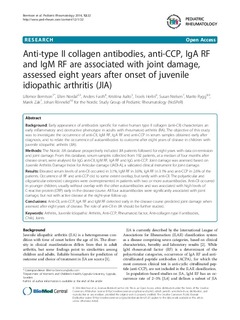| dc.description.abstract | Background: Early appearance of antibodies specific for native human type II collagen (anti-CII) characterizes an
early inflammatory and destructive phenotype in adults with rheumatoid arthritis (RA). The objective of this study
was to investigate the occurrence of anti-CII, IgM RF, IgA RF and anti-CCP in serum samples obtained early after
diagnosis, and to relate the occurrence of autoantibodies to outcome after eight years of disease in children with
juvenile idiopathic arthritis (JIA).
Methods: The Nordic JIA database prospectively included JIA patients followed for eight years with data on remission
and joint damage. From this database, serum samples collected from 192 patients, at a median of four months after
disease onset, were analysed for IgG anti-CII, IgM RF, IgA RF and IgG anti-CCP. Joint damage was assessed based on
Juvenile Arthritis Damage Index for Articular damage (JADI-A), a validated clinical instrument for joint damage.
Results: Elevated serum levels of anti-CII occurred in 3.1%, IgM RF in 3.6%, IgA RF in 3.1% and anti-CCP in 2.6% of the
patients. Occurrence of RF and anti-CCP did to some extent overlap, but rarely with anti-CII. The polyarticular and
oligoarticular extended categories were overrepresented in patients with two or more autoantibodies. Anti-CII occurred
in younger children, usually without overlap with the other autoantibodies and was associated with high levels of
C-reactive protein (CRP) early in the disease course. All four autoantibodies were significantly associated with joint
damage, but not with active disease at the eight-year follow up.
Conclusions: Anti-CII, anti-CCP, IgA RF and IgM RF detected early in the disease course predicted joint damage when
assessed after eight years of disease. The role of anti-CII in JIA should be further studied.
Keywords: Arthritis, Juvenile Idiopathic Arthritis, Anti-CCP, Rheumatoid factor, Anti-collagen type II antibodies,
Child, Joints | nb_NO |
| dc.description.localcode | © 2014 Berntson et al.; licensee BioMed Central Ltd. This is an Open Access article distributed under the terms of the Creative Commons Attribution License (http://creativecommons.org/licenses/by/4.0), which permits unrestricted use, distribution, and reproduction in any medium, provided the original work is properly credited. The Creative Commons Public Domain Dedication waiver (http://creativecommons.org/publicdomain/zero/1.0/) applies to the data made available in this article, unless otherwise stated. | nb_NO |
